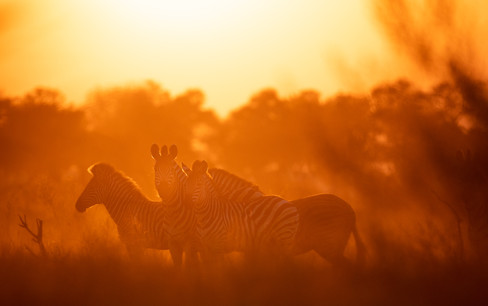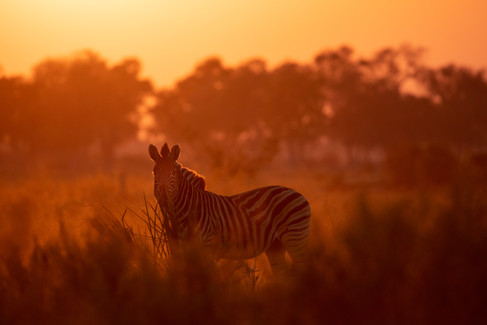Every day, our cameramen rise at the crack of dawn to catch nature at its finest. Why? Dawn and dusk are what is known as the “golden hours” of filming. They are the most important times of the day for our cameramen to capture those stunning moments that bring a documentary together. From an exhausted cheetah breathing out golden gusts of air, to a backlit lion cub gazing out from its termite mound tower and elephants kicking up clouds of blood-red dust into the last light of the day, during these magical hours the world around you is suddenly transformed. New colours and textures are revealed, the sky heaves with the frantic movements of golden insects, and the residents of the Delta emerge from their slumbers to revel in its cool conditions.
A warthog emerges from its burrow.
The residents of the Okavango Delta are used to the scorching Kalahari heat. Fortuitously for our cameramen, the golden hours are not only the most beautiful of the day, but also the coolest. Animal activity in the Delta is busiest around dusk and dawn. Midday, on the other hand, can be excruciatingly hot. Most animals spend this time in the shade offered by African Ebony and Kigalia tress, or in cool burrows underground, conserving their energy for later. African Wild Dogs are a classic example. Wild dogs have more offspring than any other Canid, with litters of up to 20 pups at a time. With all those extra mouths to feed, the pack must hunt twice a day. Starting before dawn, these extraordinarily successful predators usually take down their first victim just as the sun breaks over the horizon. After a long midday snooze through the heat of the day (much to the relief of our cameramen), and a lot of sneezing and yipping, the hunting party set off once more. If the cameramen gets lucky again, the dogs will take down their next prey before the sun dips once again.
As the sun sets, temperatures cool, and the Kalahari's residents increase their activity.
Here at the NHFU, we craft stories inspired by the world around us. Storytelling is the crux of every human interaction, so it’s how we break down the extraordinarily complex symbioses and interactions that go on all around us to bring them to life for our audience. But what we’re doing is nothing new. For centuries, sunrise and sunset have inspired beautiful and fascinating folklore amongst the San of Botswana, created to make sense of the world around them, just as we do with our documentaries. In conversation with Senabe, a San Riverman and the star of our recent “Okavango: A Flood of Life”, we learned of some of the ancient beliefs surrounding these mystical hours:
“This story starts with a lonely crocodile who long envied the beauty and magic that the Sun possessed. This forlorn crocodile presented an idea of his to the sun, to which, after much persuasion, she finally agreed. The plan went that every evening after the Sun had to set in the West, the eager crocodile would swallow her fiery beauty and proceed to swim all the way back across the river to the East, where she would pass back through the crocodile ready to rise again for a new day. This way the crocodile was able to spend the whole night living with the Sun’s beauty within him.”
A leopard makes the most of the golden hours to hunt and stalk her prey.
But the power of the golden hours does not end there for the San. Healing rituals that begin at sunset and continue throughout the night to sunrise are an ancient San tradition. Participants dance, sing and clap around the fire until entering a state of trance, during which the healing process begins and the individual experience an out-of-body experience, supposedly even giving them the ability to dance on the fire. Now that tourism is set to reopen in Botswana, we couldn’t recommend more than you come and see a true African sunrise and sunset for yourself. We can’t promise that you’ll be able to dance on fire, but we can promise that the sight of our blood-red sun dipping beyond the horizon is a sight you will never forget.

Written by Hannah Gormley and Amy-Jean Beattie






















Σχόλια